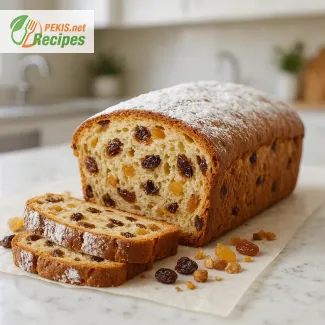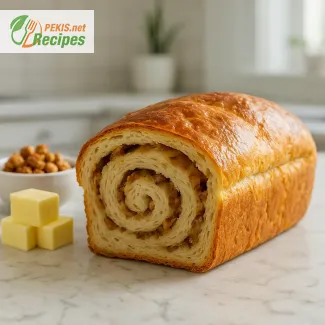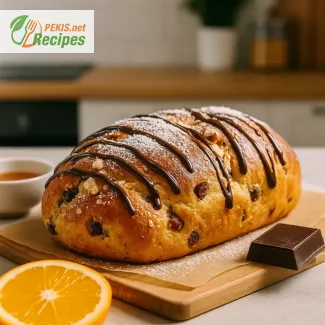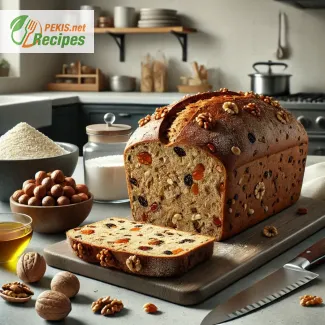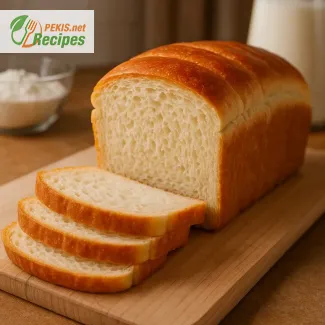
Traditional Slovak Easter Paska – A Heritage Bread with Soft Crumb and Rich Flavor
Discover the Heartwarming Story Behind This Iconic Slovak Loaf
Every culture has its own sacred Easter bread, but few are as beloved and symbolic as Slovak Paska. This light, golden loaf, traditionally enjoyed during the Easter season, carries with it generations of Slovak heritage and the warm spirit of celebration. Rich with eggs, butter, and milk, it’s a bread that represents abundance, renewal, and family togetherness. Whether baked in the traditional round form or shaped with intricate braids and crosses, this bread is as beautiful as it is delicious.
The fluffy interior and the shiny golden crust are the results of time-honored techniques passed down from grandmothers who spent days preparing for the Easter feast. With its slightly sweet taste, enriched dough, and symbolic decorations, Slovak Paska stands proudly as the centerpiece of the holiday table, often nestled among dyed eggs, smoked meats, and other Easter delicacies in a woven basket blessed at church.
Unlike simpler loaves, Paska is enriched with a generous number of eggs and a high-fat content that makes it incredibly soft, tender, and aromatic. The dough rises patiently, sometimes more than once, allowing its structure to develop while the flavor deepens. Traditionally flavored with a hint of vanilla or citrus zest, it is unmistakably festive but versatile enough to be enjoyed with both sweet and savory dishes.
In Slovakia, baking Paska isn’t just culinary – it’s a spiritual and communal event. Families gather to prepare the dough, children help shape the loaves, and elders ensure the braids and crosses are placed just right. The scent that fills the house as it bakes is a gentle reminder that something sacred is being prepared.
The final loaf is rich in symbolism. The cross on top represents Christ’s resurrection, while braids may symbolize the Trinity or the crown of thorns. Some variations include decorative swirls, flowers, or birds, depending on regional traditions and family customs. This bread isn't just food – it's a prayer in the form of a loaf, meant to bless the household and honor the cycle of life and faith.
Although traditionally baked for Easter, this recipe has timeless appeal. Its soft crumb, subtle sweetness, and buttery finish make it ideal for any occasion where you want to offer something heartfelt and homemade. Whether served simply with butter, paired with cured meats, or enjoyed with honey, each slice is a taste of tradition.
If you're new to Slovak baking, this is the perfect introduction. The recipe is approachable, rewarding, and rich in heritage. For those with Slovak roots, it’s a way to reconnect with family and memory. And for everyone else, it’s a delicious invitation into a tradition that welcomes all with warmth and generosity.
By mastering this recipe, you're not just baking a loaf – you're bringing to life a piece of history that has traveled across generations and borders. This Slovak Paska is more than bread; it's a celebration of love, hope, and renewal, wrapped in golden crust and tender crumb. Let your kitchen be filled with the aroma of tradition, and share in a joy that has fed hearts and souls for centuries.
1. Activate the yeast
Warm the milk (250 ml / 1 cup) to lukewarm (about 98°F / 37°C). Stir in the sugar (100 g / ½ cup) and yeast (7 g / 2 ¼ tsp). Let the mixture sit for 10 minutes until frothy.
2. Prepare the dough
In a large mixing bowl, combine the flour (700 g / 5 ⅔ cups) and salt (5 g / 1 tsp). Create a well in the center and add the beaten eggs (4), melted butter (120 g / ½ cup), vanilla extract (5 ml / 1 tsp), lemon zest, and the activated yeast mixture. Stir to form a rough dough.
3. Knead the dough
Knead the dough by hand or using a dough hook for 10–12 minutes until it becomes smooth and elastic. It should be soft but not sticky. Add a little more flour if needed, 1 tablespoon at a time.
4. First rise
Place the dough into a lightly oiled bowl, cover with a clean towel or plastic wrap, and let it rise in a warm place for 90 minutes or until doubled in size.
5. Shape the dough
Punch down the dough and divide it into two equal portions. Shape each portion into a round loaf and place into greased 8-inch (20 cm) round cake pans. Use reserved dough to create traditional braids or crosses on top if desired.
6. Second rise
Cover the loaves loosely and let them rise for another 60 minutes until noticeably puffed.
7. Preheat oven
Preheat your oven to 350°F (180°C) during the second rise.
8. Egg wash and bake
Gently brush the loaves with the beaten egg wash. Bake for 35–40 minutes, or until golden brown and the loaves sound hollow when tapped.
9. Cool and serve
Let the bread cool in the pans for 10 minutes before transferring to wire racks. Allow to cool completely before slicing.
Elevating Slovak Paska Bread with Thoughtful Twists and Time-Honored Techniques
Explore how small changes can make a big difference in this traditional Easter bread
Traditional Slovak Paska bread is already a masterpiece of cultural heritage and taste, but even classic recipes can be subtly enhanced to suit modern preferences or elevate flavor and texture. While maintaining the heart of the original, experimenting with certain ingredients, preparation methods, and health-conscious alternatives can result in a more refined or personalized version of this beloved Easter loaf. Whether you're a seasoned baker or trying it for the first time, understanding the nuances of this recipe can help you achieve a flawless result.
Enriching flavor and texture through ingredient upgrades
One of the most effective ways to refine Paska is by improving the quality of the ingredients. Traditional recipes often call for standard pantry items, but choosing higher-quality or fresher versions can make a noticeable difference:
- Milk: Using full-fat, organic milk adds a creamier richness to the dough. Alternatively, infusing the milk with a cinnamon stick or crushed cardamom pods before mixing can impart a subtle aromatic warmth.
- Butter: Replace standard unsalted butter with European-style butter, which contains a higher fat content and delivers a deeper, more luxurious mouthfeel.
- Flour: For a softer crumb, consider blending all-purpose flour with a portion of cake flour. The lower protein content reduces gluten development, resulting in a delicately tender bread.
You can also enhance the dough by incorporating flavor-boosting additions:
- A teaspoon of orange or lemon extract complements the traditional zest and brightens the overall flavor.
- Adding a pinch of ground nutmeg gives a subtle, warm complexity.
- Replacing some of the sugar with honey adds depth and moisture, contributing to a slightly caramelized note.
Making it healthier without compromising tradition
While Paska is typically a rich, celebratory bread, it can be adjusted to be more nutritious for those looking to balance tradition with health.
- Whole wheat flour: Substitute up to 30% of the white flour with whole wheat flour. This increases fiber and mineral content without drastically changing texture.
- Plant-based milk: Unsweetened almond or oat milk can be used in place of cow's milk to reduce saturated fats and make the loaf dairy-free.
- Egg replacements: For an egg-free version, ground flaxseed mixed with water or unsweetened applesauce works as a binder, ideal for vegan adaptations.
- Natural sweeteners: Replace white sugar with coconut sugar, maple syrup, or date syrup for lower glycemic options and richer flavor profiles.
Why homemade Paska is always the superior choice
Choosing to make Slovak Paska at home is not only rewarding, but also significantly improves taste, texture, and nutritional value. Freshly baked bread lacks the preservatives and additives often found in store-bought versions. You control every ingredient, adjusting to dietary needs or personal flavor preferences. Furthermore, the aroma and ritual of baking Paska from scratch transform it into more than food — it's a celebration of heritage, creativity, and care.
Homemade Paska also allows for meaningful customization:
- Shape your loaves with braids, swirls, or decorative cutouts, making them visually appealing and symbolic.
- Add a homemade glaze with sugar and milk or a drizzle of citrus icing for a modern, dessert-like twist.
Avoiding common mistakes for the perfect loaf
Achieving that ideal Paska loaf involves more than following the recipe—it’s also about technique and awareness. Here are some frequent pitfalls and how to avoid them:
- Over-proofing the dough: Allowing it to rise too long can lead to a weak structure and deflated top. Stick to the recommended time and look for visual cues (dough doubling in size).
- Too much flour: Adding excessive flour during kneading leads to a dense, dry texture. The dough should remain slightly tacky but manageable.
- Skipping the egg wash: This crucial step gives the bread its signature golden sheen. For extra shine, brush the loaves twice before baking.
- Incorrect oven temperature: Baking at too high a temperature can result in a burnt crust and undercooked center. Always preheat your oven and use a thermometer if needed.
Customizing the recipe for different occasions
Though Paska is traditionally baked for Easter, the base recipe is wonderfully adaptable. For different occasions, consider:
- Adding dried cranberries or raisins soaked in rum or orange juice for a festive touch.
- Swirling in sweetened poppy seed or walnut filling for regional authenticity and indulgence.
- Topping with pearl sugar or slivered almonds for added texture and visual appeal.
These additions not only diversify the bread but also allow it to align with various seasonal celebrations, from Christmas to weddings.
Exploring cultural and emotional connections
Enhancing a traditional recipe like Slovak Paska is not about replacing its soul but deepening the connection to it. Every ingredient and technique you choose can reflect your own story, dietary needs, or culinary goals. Whether baking for loved ones, continuing a family ritual, or creating new traditions, this bread is an edible heirloom—a canvas for memory and meaning.
By understanding how ingredients, methods, and mindfulness contribute to its outcome, you’re not just baking Paska. You’re reviving and enriching a timeless tradition that speaks to flavor, love, and legacy.
Allergens present in this recipe:
- Gluten (from all-purpose flour)
- Eggs
- Dairy (milk and butter)
Tips to replace allergens and gluten:
- Gluten-free version: Substitute the flour with a gluten-free bread flour blend and add 1 teaspoon of xanthan gum.
- Dairy-free version: Replace whole milk with almond milk or oat milk, and butter with a plant-based alternative.
- Egg-free version: Use ¼ cup (60 ml) unsweetened applesauce or 1 tablespoon of ground flaxseed mixed with 3 tablespoons of water for each egg.
- Vitamin A: 210 µg – supports healthy vision and immune response
- Vitamin D: 0.7 µg – essential for calcium absorption and bone health
- Vitamin B12: 0.4 µg – important for red blood cell production
- Iron: 1.5 mg – aids in oxygen transport and energy production
- Calcium: 25 mg – necessary for strong bones and teeth
- Magnesium: 15 mg – supports muscle and nerve function
- Zinc: 0.8 mg – contributes to immune system performance
- Folate: 55 µg – vital for cell growth and prenatal development
- Selenium: 9 µg – helps prevent oxidative stress and supports thyroid health
- Lutein + Zeaxanthin: 40 µg – promote long-term eye health
- Vitamin E: 0.5 mg – protects cell membranes and supports immune function

